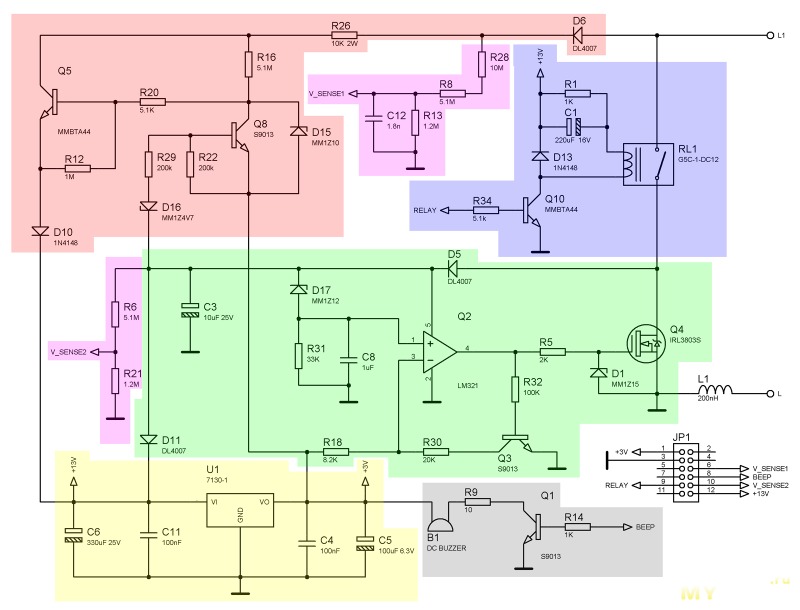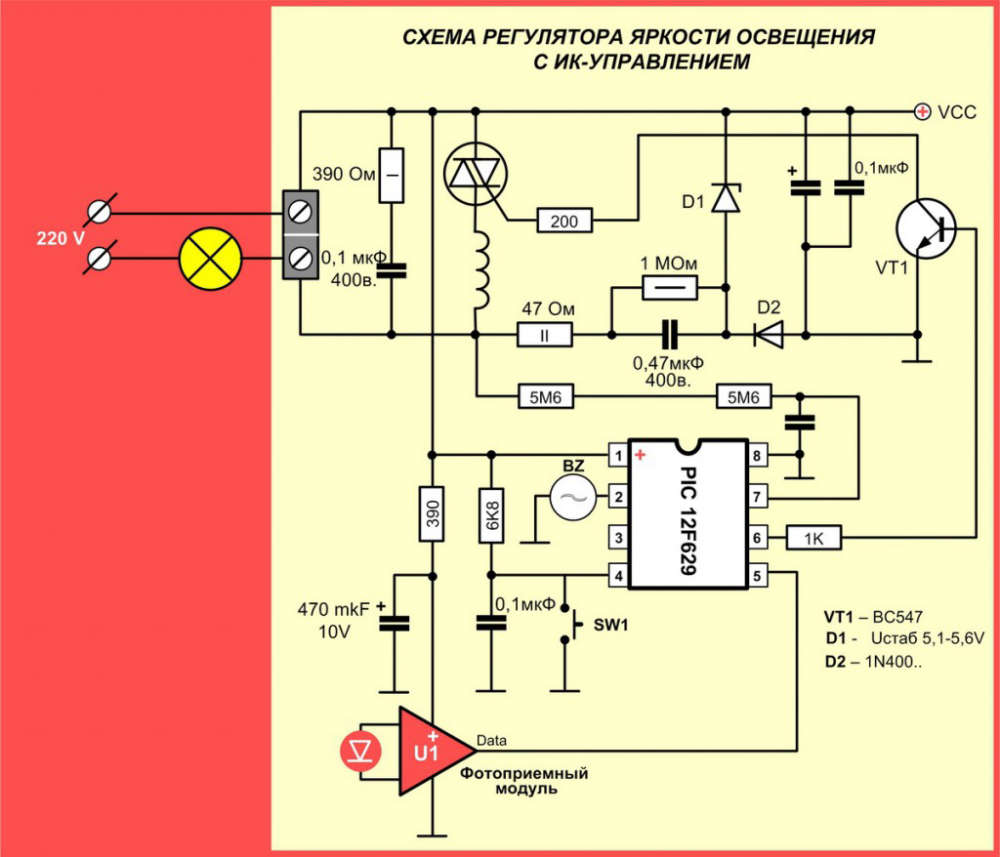@scalz thanks a lot for comprehensive recommendation. Will take a look, all is new for me
axillent
Posts
-
Looking for a good platform to programm webserver linked to webservices -
Looking for a good platform to programm webserver linked to webservicesMy iot network is requiering development a management console based on web interface
To control, analyse and configureAccess to network is throuth webservices
Any ideas of simple to start platform for this project?
My basic idea is php with some libraries
But may be a specially designed framework exists -
AC-DC at own@jeremushka I do have this footprint in altium but the library is big. do you know how to export a single element?
-
Concept of a flexible but simple smart networkLinux Router https://github.com/axillent/swi_appserver
-
Concept of a flexible but simple smart networkjust published my libraries
anyonw is welsome on review and comments https://github.com/axillent :-
list item stavrp C++ multiplafrom suport library, platforms are at different level of support
-
list item smartletsp C++ smart devices network
-
list item swilib and integration of above two libraries with arduino framework
-
-
Concept of a flexible but simple smart networkalso from last
byteorder handling is build in
library allows to choose any order
I select bigendian because this is natural to my major MCU - STM8
on little endian platforms (like STM32, ESP8266 and ARM64) data is automatically translated -
Concept of a flexible but simple smart networkfor esp8266 i made an universal bridge application
it can be used for both:-
single node, esp8266 is running a final application. on the photo above my thermostats to measure room temperature, report it and to send ON/OFF commands to heaters
-
bridge. can be used to connect other type networks wirelessly to application server. UART is used for this + json translation. currently this is implemented to connect heating controllers located on each floor
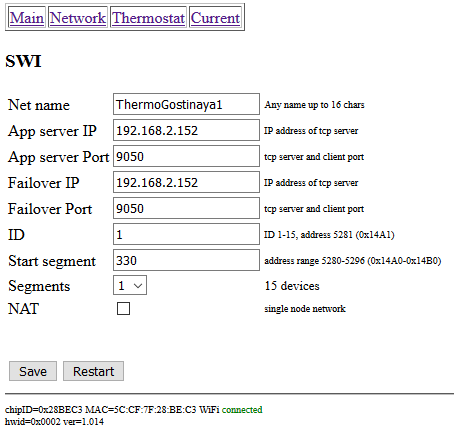
main and failover servers can be configured
also each node is configured to handle from one to a few network segments. this allows simple routing from application server back to node
esp8266 is using ArduinoOTA and zero hardcording.
after fresh programming esp creates AP and smartphone can be used to preconfigure a node
any updates are keeping configuration except major updates there stored structure can be affectedapplication server is also support MQTT translation
etc. it looks like a routing between my network and MQTT server
RX/TX adresing are mapped to MQTT topic while message is translated into JSON:
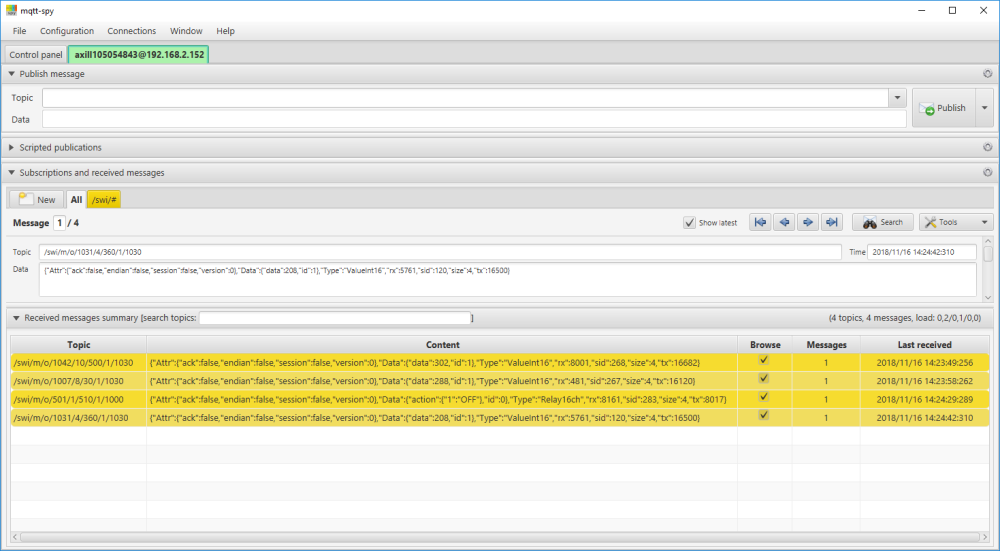
-
-
Concept of a flexible but simple smart networkmade a few steps forward
launched ESP8266 node & bridge and STM32 bridge and TCP/IP router based on linux (orangepi)
bellow is my working example
list of supported platforms:- STM8S/IAR
- STM32F0/Keil - draft
- ATMEL/Atmel studio - draft
- Arduino ESP8266
- Arduino STM32
- Linux/g++
i;m working on 2 libs. first is to handle platform dependant things. second is platform independant smart devices network
regardless platform and regardless communication hardware the framework allows to transfer messages using RX/TX notation with 16 bit global addressing.
Addressing is organized as 4096 segments where 4094 are 15 node segments each and 2 segments are for broadcadstingframework allows to connect potentially absolutelly different communication hardware
currently i'm running:- simple one wire (1 wire signal + 2 wire power) network
- wifi based nodes
- twisted pair connected ethernet devices
bridge between different types of network is organized on TCP/IP application server running currently on linux
etc. potentially allows to connect network segments regardless physicall location, only internet connection is requiredwhy i'm doing this? mostly for fan but also to implement 2 principles:
- application layer to be independant from hardware and transport. message format is universal and is the same regardless platform and communication hardware. Addressing is also universal. Application should not take care about intermediate specific, this is handled by other components
- avoid a central unit. each device can communicate with each device. the only central component is application server. but is is very simple, robust and reliable. failover is supported
My example:

-
What did you build today (Pictures) ?bridge from single wire (my w3p manchester based) to UART. will be used to bridge single wire network with Ethernet throuth ESP8266 or STM32 + Wiznet
second photo - development stand with w3p bus
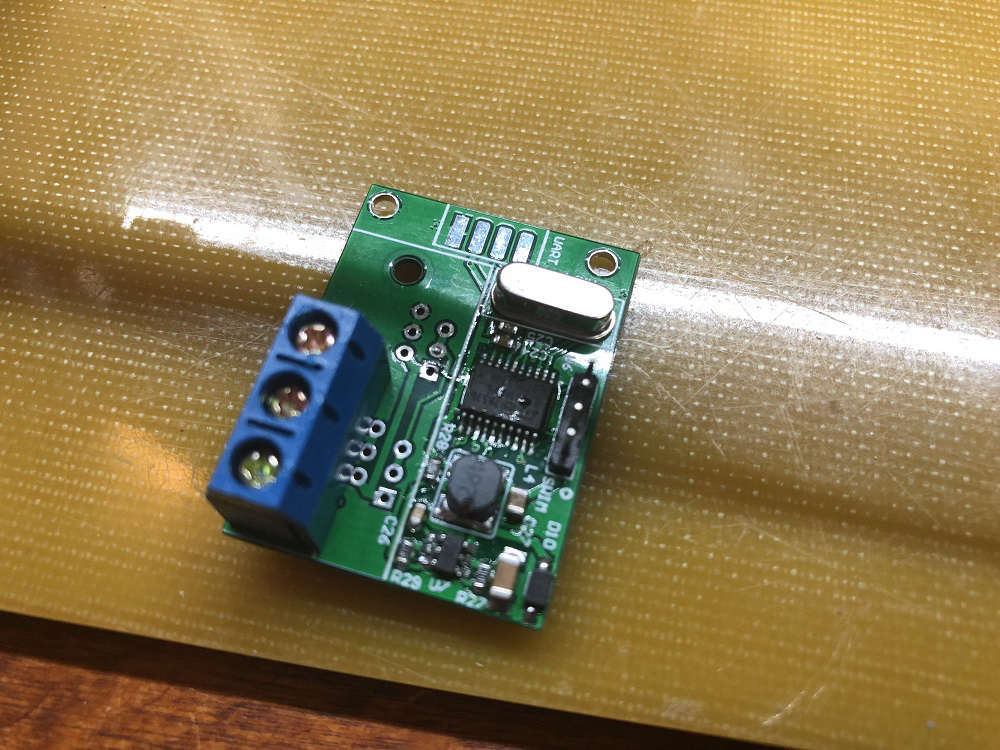
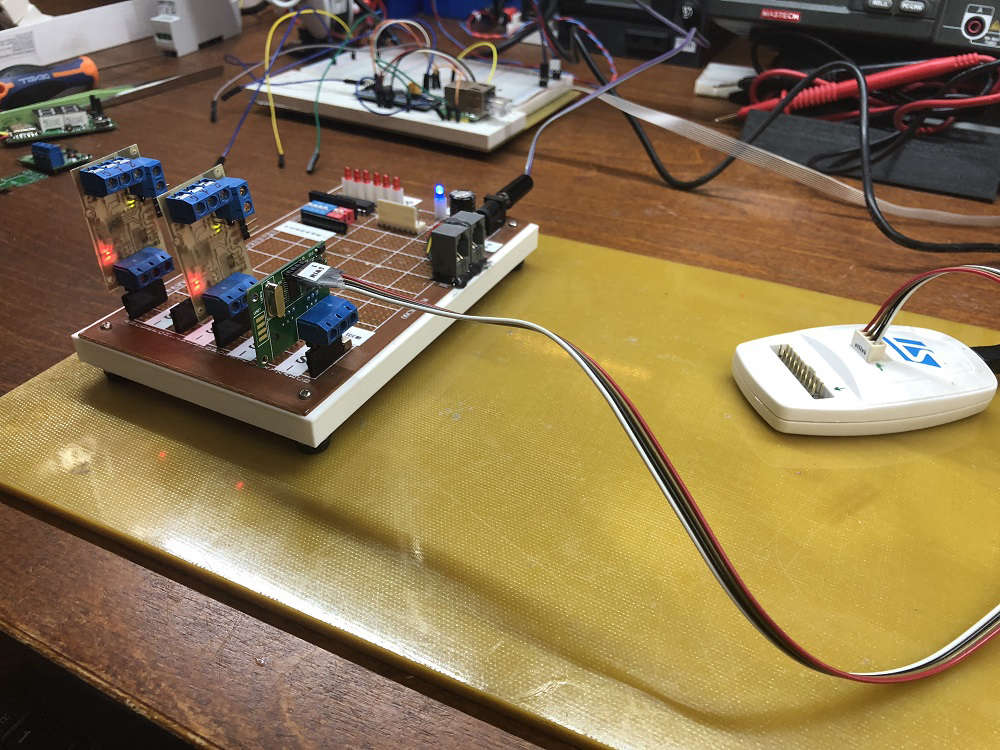
-
What did you build today (Pictures) ?esp8266 based thermostat for heating system
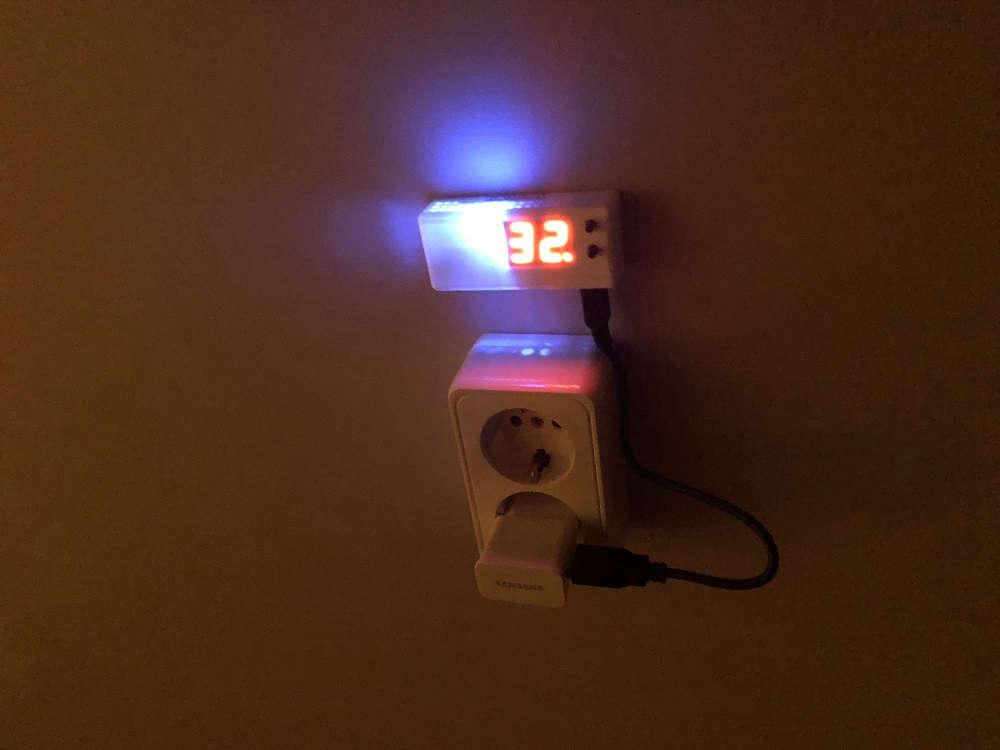
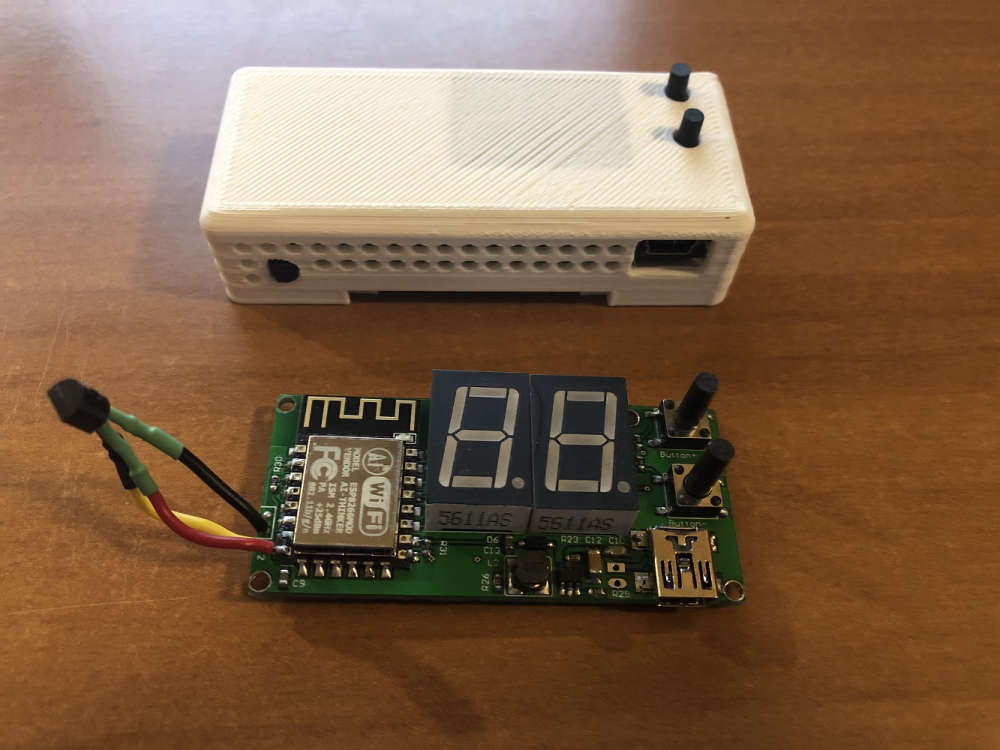
-
Reliable 5v buck converter recommendations?@zboblamont said in Reliable 5v buck converter recommendations?:
Surprised no recommendations offered, so trial and error it will have to be...
Ordered up two XL4015 5A capable 5v boards before Trump modifies free postage ;) . $3 for two (one as a spare), doubt I could build even one at that price, just the 2 week/months slow boat to wait for.
The general idea for the UPS being followed is per link text, the PSU, case and battery are easy enough local sourced, and plenty of time to decide whether USB or direct wiring is the choice of powering up the Pi..XL4015 will work for you. It is not the best performer but it will do a job.
If I got your question correctly you do need a module to step down from acis battery (nominal 13.2V maximum 14.6) to 5V up to 3A contineous. Right?Best performers in steping down are so called synchronous rectifiers. The eseest to find as a modules is a module based on MP2307. Also a good selection will be a modules based on MP2315. Both are 3A maximum.
-
Your best advice on buying components?@fredswed I think to care too much about selecting source of items.
I also tried different ones including ebay, mouser, farnel, sparkfun etc. end up to use only (mostly) ali.
Spending time to analyse goods presented you will find that most sellers are providing same goods.
The only difference between them is price and quality of service.Finally I refused to keep track on a particular sellers. Each time I need something I do search for best price and most sells and looking into ratings and customers feedback refuse worstest ones. Each such search requires just a few minutes to end up with purchase.
In practice using such approach in most cases you will purchase from a small set of sellers. But there is no need to depend on them. In case of mistake in selecting seller you will call for your money.
All this for DIY purpose. Time is not a critical issue.
If you are about doing some commersial staff it is always a different story -
Your best advice on buying components?@flopp In my understanding all this DIY shops are managing whemselves. So wharegousing strategy is up to concrete store.
From my experience I'm getting some parcels from EU, many from Latvia, some from Finland and some from others. -
Concept of a flexible but simple smart networkjust to illustrate how translation is working
you do not need direct logic match between abstract layer and the layer of used interfacehere is how translation is working between my network and MQTT broker:

bellow is initialization of 2 different nodes attached to 2 different interfaces, one to TCP/IP network, other to MQTT broker
it is a code from linux application server//----------------------------------------------------------------------------------------- // Nodes //----------------------------------------------------------------------------------------- // --- inet typedef Smartlets::Common::RouteTableFile RouteTable; typedef STAVRP::Linux::TCPDrv<0> TCPDrv; typedef Smartlets::Interface::Translator::INet<Message, TCPDrv, RouteTable> TranslINet; typedef Smartlets::Interface::P2P<Message, TranslINet, 16, 16> InterfaceINet; typedef Smartlets::Node::NodeBasic<Message, InterfaceINet, ApplInet> NodeINet; // --- mqtt typedef Smartlets::Interface::Translator::Mqtt<Message> TranslMqtt; typedef Smartlets::Interface::P2P<Message, TranslMqtt, 16, 16> InterfaceMqtt; typedef Smartlets::Node::NodeBasic<Message, InterfaceMqtt, ApplMqtt> NodeMqtt;Inside Translator:Mqtt the following is used for example inside TX method (sending message):
static bool TX(const Message& msg) { char key[128]; if( msg.header.tx.IsBroadcast() ) sprintf(key, "/%s/bc/o/%d/%d/%d/%d", data.swi_domain.c_str(), msg.header.tx.GetBroadcastID(), msg.header.rx.GetNetSegment(), msg.header.rx.GetNetDevID(), msg.header.type.type); else sprintf(key, "/%s/m/o/%d/%d/%d/%d/%d", data.swi_domain.c_str(), msg.header.tx.GetNetSegment(), msg.header.tx.GetNetDevID(), msg.header.rx.GetNetSegment(), msg.header.rx.GetNetDevID(), msg.header.type.type); std::string payload = json_ext::FromMessage(msg); data.drv.TXPut(STAVRP::Linux::MqttEntry(key, payload)); return true; }``` and this is how it is finally bridged between:while(1) { //--------------------------------------------------------------------------- // loop inet //--------------------------------------------------------------------------- if( NodeINet::Loop() ) { Message msg = NodeINet::RX(); Logger::root() << log4cpp::Priority::DEBUG << "inet-> tx=" << msg.header.tx.id; NodeINet::CommitRX(false); // --- routing if( NodeINet::TX(msg) ) { Logger::root() << log4cpp::Priority::DEBUG << "inet->inet TX OK"; // delayed queue } else { Logger::root() << log4cpp::Priority::ERROR << "inet->inet TX failed"; } if( NodeMqtt::TX(msg) ) { Logger::root() << log4cpp::Priority::DEBUG << "inet->mqtt TX OK"; } else { Logger::root() << log4cpp::Priority::ERROR << "inet->mqtt TX failed"; } } //--------------------------------------------------------------------------- // loop mqtt //--------------------------------------------------------------------------- if( NodeMqtt::Loop() ) { Message msg = NodeMqtt::RX(); Logger::root() << log4cpp::Priority::DEBUG << "mqtt-> tx=" << msg.header.tx.id; NodeMqtt::CommitRX(false); if( NodeINet::TX(msg) ) Logger::root() << log4cpp::Priority::DEBUG << "mqtt->inet TX OK"; else Logger::root() << log4cpp::Priority::ERROR << "mqtt->inet TX failed"; } sleep(1); }``` -
Concept of a flexible but simple smart network@kimot the main idea of all my project is to manage network abstraction layer regardless hardware
only translation + driver layers are hardware related, but them allow to transfer logical layer data throuth any physical hardware
my 16bit addressing could be translated to addresses used by your hardware to keep handle communication based on hardware advantages.I just launched a network with translation throuth Ethernet/TCP with application server running on orangepi
Working pretty well. On logical level it is always 16bit addressing with broadcasting support.
developing device you should not take care how message will reach another device
this is handled while developing appropriate translations/drivers on bridge side.bridge - a device connecting 2 or more different physycal layers.
it is also allows to crate a building blocks.
For example I'm running ESP8266 with TCP interface to network on one side and UART&JSON interface on other side
attaching MCU to ESP by UART a can connect any kind of network to my network -
Concept of a flexible but simple smart network@zeph yes and no. it is very very simple hardware, similar to LocoNet. allows to transfer a few kbit/sec on single wire (w3p - 3 wire VCC + Signal + GND) using 1 npn transistor + 4 resistors at absolute minimum
-
DIN Rail LEGOwifi router got a firmware and box
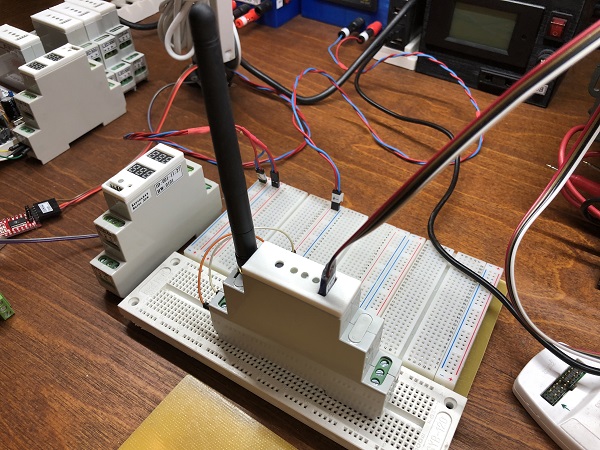
can be cloned as many as needed, one per simple network segment
it is managing automated routing between segments -
AC-DC at own@jeremushka said in AC-DC at own:
Thanks for the answer. i will play with this LNK component. never used it before. I am curious to know the performances of it.
for your design, you have added others functions on your PCB ? such as DC-DC converter ... etc.. ?my DIN desing is universal. it is for the set of different devices with common 12V power
dc-dc is used to feed MCU from 12V -
AC-DC at own@jeremushka said in AC-DC at own:
some questions regarding the schematics:
- does TVS diode 600W 5V is efficient enough? or absolutely need cut off at 160V such as 600W 160A ?
- for the Fuse, a slow fuse 10A is enough i think, isn't it?
TVS need to be for 120-160V in case you supply 230V AC. You can refer to linkswitch designer for your specific needs.
The purpose of this TVS is to be a snubber because of inductive load. Instead of TVS an RC snubber could be used.it is 3Watts supply, 0.5-1A slow fuse is fine
-
AC -DC transformer sourcinga few examples without transformer
